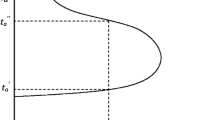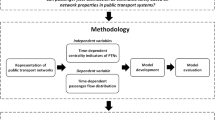Abstract
Having accepted the need for the development of simpler and less cumbersome transport demand models, the paper concentrates on one possible line for simplification: estimation of trip matrices from link volume counts. Traffic counts are particularly attractive as a data basis for modelling because of their availability, low cost and nondisruptive character. It is first established that in normal conditions it may be possible to find more than one trip matrix which, when loaded onto a network, reproduces the observed link volumes. The paper then identifies three approaches to reduce this underspecification problem and produce a unique trip matrix consistent with the counts. The first approach consists of assuming that trip-making behaviour can be explained by a gravity model whose parameters can be calibrated from the traffic counts. Several forms of this gravity model have been put forward and they are discussed in Section 3. The second approach uses mathematical programming techniques associated to equilibrium assignment problems to estimate a trip matrix in congested areas. This method can also be supplemented by a special distribution model developed for small areas. The third approach relies on entropy and information theory considerations to estimate the most likely trip matrix consistent with the observed flows. A particular feature of this group is that they can include prior, perhaps outdated, information about the matrix.
These three approaches are then compared and their likely areas for application identified. Problems for further research are discussed and finally an assessment is made of the possible role of these models vis-a-vis recent developments in transport planning.
Similar content being viewed by others
References
Atkins, S. T. (1977) “Transportation planning: is there a road ahead?” Traffic Engineering and Control 18, (2): 58–62.
Beckman, M. et al. (1956) Studies in the Economics of Transportation. Newhaven: Yale University Press.
Blanchard, R. (1976) “Transportation and the new planning.” High Speed Ground Transportation Journal, 10, (1): 13–30.
Dial, R. B. (1972) “A probabilistic multipath assignment model which obviates path enumeration.” Transportation Research, 5, (2): 83–111.
Hall, M. D., Van Vliet, D. and Willumsen, L. G. (1980) “SATURN — a simulation-assignment model for the evaluation of traffic management schemes.” Traffic Engineering and Control, 21 (4): 168–176.
Heggie, I. (1978) “Putting behaviour into behaviour models of travel choice.” Journal of Operation Research Society, 29: 541–550.
Hogberg, P. (1986) “Estimation of parameters in models for traffic prediction: a nonlinear regression approach.” Transportation Research, 10: 263–265.
Holm, J. et al (1976) “Calibrating traffic models on traffic census results only.” Traffic Engineering and Control, 17: 137–140.
Jörnsten, K. O. and Nguyen, S. (1979) On the estimation of a trip matrix from network data. Linköping University Research Report LiTH-MAT-R-79-36, Linköping.
Kurth, D., Schmeider, M. and Gur, Y. (1979) “A small area trip distribution model.” Proc. 58th Annual Meeting of the Transportation Research Board.
Low, D. (1972) “A new approach to transportation systems modelling.” Traffic Quarterly, 26: 391–404.
Murchland, J. (1977) The multiproportional problem. Research Note JDM263, Transport Studies Group, University College, London.
Nguyen, S. (1977) Estimating an O-D matrix from network data: a network equilibrium approach. Publication No. 87., Centre de Recherche sur les Transports. Universite de Montreal.
Nguyen, S. (1978) On the estimation of an O-D trip matrix by the equilibrium methods using pseudo delay functions. Publication 81, Centre de Recherche sur les Transports, Universite de Montreal.
OECD Road Research Group (1974) Urban Traffic Models: Possibilities for Simplification. Paris: OECD.
Robillard, P. (1975) “Estimating an O-D matrix from observed link volumes.” Transportation Research, 9: 123–128.
Smith, R. and McFarlane, W. (1978) “Examination of a simplified travel demand model.” Transportation Engineering Journal of ASCE, 104, No. TE. 1: 31–41.
Smock, R. (1962) “An iterative assignment approach to capacity restraint on arterial networks,” Highway Research Board Bulletin, 347: 60–66.
Symons, J., Wilson, R. and Patterson, J. (1976) “A model of inter-city motor travel estimated by link volumes.” ARRB Proceedings, vol. 8 Session 20: 53–65.
Turnkist, M. and Gur, Y. (1979) “Estimation of trip tables from observed link volumes.” Proc. 58th Annual Meeting of the Transportation Research Board.
Van Vliet, D. and Dow, P. D. C. (1979) “Capacity-restrained road assignment.” Traffic Engineering and Control, 20: 296–305.
Van Zuylen, H. (1978) “The information minimising method: validity and applicability to transport planning” in G. R. H. Jansen et al. (editors) New Developments in Modelling Travel Demand and Urban Systems.
Van Zuylen, H. and Willumsen, L. G. (1980) “The most likely trip matrix estimated from traffic counts.” Transportation Research Ser. B., 14B: 281–293.
Wilson, A. G. (1970) Entropy in Urban and Regional Modelling. London: Pion.
Williams, H. C. W. L. and Ortuzar, J. D. (1979) Behavioural travel theories, model specification and the response error problem. Institute for Transport Studies, Working Paper 116, University of Leeds.
Willumsen, L. (1978) Estimation of an O-D matrix from traffic counts: a review. Institute for Transport Studies Working Paper 99, University of Leeds.
Willumsen, L. G. (1979) “Estimating the most likely O-D matrix from traffic counts.” Proc. 11th Universities Transport Study Group Conference, Southampton. (unpublished).
Willumsen, L. G. (1980) “Appropriate transport planning techniques for developing countries.” Proc. World Conference on Transport Research, London 1980.
Author information
Authors and Affiliations
Rights and permissions
About this article
Cite this article
Willumsen, L.G. Simplified transport models based on traffic counts. Transportation 10, 257–278 (1981). https://doi.org/10.1007/BF00148462
Issue Date:
DOI: https://doi.org/10.1007/BF00148462




